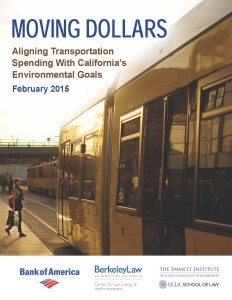On Sunday I was interviewed on KCBS News Radio in San Francisco about how California can better spend its transportation dollars. It’s the subject of the new UC Berkeley / UCLA Law report Moving Dollars. I posted the audio, which you can listen to here:
On the heels of the UC Berkeley / UCLA Law report released yesterday, the Sacramento Bee is running on op-ed from me today with recommendations on improving California’s transportation spending:
Potholed roads, crumbling bridges, crowded buses and trains, collisions between cars and bicyclists. In short, California’s transportation infrastructure is in dire need of improvement.
Every year, the state, regional agencies and local governments spend about $28 billion. But are we spending that money effectively?
Too often, decision-makers would rather fund new road and highway projects instead of improving our existing infrastructure and providing more affordable and convenient transportation options. Local political considerations seem to drive these decisions, instead of the most effective use of these funds. And to make matters worse, decision-making is highly decentralized and therefore uncoordinated. Money comes from federal, state and local sources, with multiple levels of government controlling the spending.
Yet these transportation decisions affect our lives as directly as anything our government does. They help determine the layout of our towns and cities, the location of our jobs and shops, and how painlessly we can get where we need to go. The decisions by an agency in a neighboring jurisdiction can mean the difference between an easy commute and a nightmare.
You can read the whole thing here, and also hear me speak about the report at tomorrow’s Planning and Conservation League annual symposium at UC Davis.
Streetsblog LA also posted a nice write-up on the report here. And for those in the Bay Area, I’ll be interviewed about the report on Sunday at 11:20am on KCBS radio.
 California spends approximately $28 billion on transportation infrastructure each year. But are we spending that money as cost-effectively as possible? And given the major impact that transportation investments have on our land use patterns and the amount of driving we need to do, are we spending this money in ways that align with California’s environmental and energy goals?
California spends approximately $28 billion on transportation infrastructure each year. But are we spending that money as cost-effectively as possible? And given the major impact that transportation investments have on our land use patterns and the amount of driving we need to do, are we spending this money in ways that align with California’s environmental and energy goals?
The short answer is: no. The majority of these dollars go to automobile-focused infrastructure, including for new road and highway expansion projects. Yet at the same time, our existing infrastructure is crumbling and in dire need of maintenance and investment, while options for transit, biking and walking are routinely underfunded. And while the state seeks to encourage more housing in walkable, transit-friendly communities to meet market demand, too often transportation funds are directed to outlying areas, encouraging more growth at the edge at the expense of the core.
Part of the problem is that the money is collected and spent at multiple levels of government. Local governments raise almost half the transportation dollars in California and control almost three-quarters of it. Federal and state dollars are also spent via multiple agencies with sometimes competing priorities.
To address the challenge, UC Berkeley and UCLA Schools of Law are today releasing the report Moving Dollars: Aligning Transportation Spending With California’s Environmental Goals. The report resulted from a one-day gathering of transportation experts, state officials, and transportation agency representatives. It is the fifteenth in the law schools’ Climate Change and Business Research Initiative, sponsored by Bank of America, which develops policies that help businesses prosper in an era of climate change.
The group identified the following priority solutions to overcome the challenges, recommending that state and regional leaders:
- Establish rigorous performance standards for new transportation projects that ensure that they are cost-effective, reduce driving miles, and provide more transportation options, among other possible metrics;
- Reform the transportation decision-making processes by developing a common transportation vision for state agencies, with incentives for local and regional agencies to follow it; and
- Direct a greater percentage of transportation dollars to the maintenance of existing infrastructure (“fix it first”), including to make roadways safe and accessible for people who take transit, walk and bike.
I’ll be speaking about these and other recommendations this Saturday at the annual Planning and Conservation League Symposium at UC Davis Law, on a panel with California Assemblymember Richard Bloom, Pete Hathaway (Former Director of Transportation Planning, SACOG) and Kate White (Deputy Secretary, California Transportation Agency). Hard copies of the report will be available, or feel free to download a digital copy at the links above.


